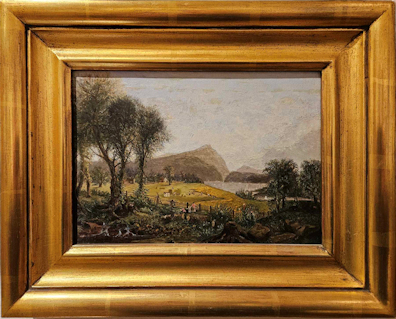|
|
|
|
|
Item #AT-0474American Harvesting, 1851 Study Oil on Panel after Jasper F. Cropsey (1823-1900)
|
|
|
|
|
Description:
After Jasper F. Cropsey (1823-1900)
"American Harvesting, 1851"
Oil on Panel
Unframed 7" x 10" W
Framed 11.25" x 14.25" W
Verso: J.F.C. 1851 in pencil. Goupil & Company Label .
Framed in Gilt Frame
This beautiful painting is a small study of a rural American landscape that was originally painted by artist Jasper Francis Cropsey. It captures the way in which he depicted the rich farmland and distant mountains represents an iconic rural American landscape. Upon closer inspection, we see many things happening in this artwork, including working farmers, animals, and a distant lake. The setting is peaceful and allows the viewer to imagine the sounds and smells of rural life.
|

|
|
|
|
Born on Staten Island, New York, Jasper Cropsey became a nationally known luminist landscape painter whose work reflects his interest in architecture and allegorical progression, seasons, etc. Called "America's painter of autumn", he was especially known for his sunlit-ridden fall landscapes.
Reportedly the peak of his career was the creation of a "nine-foot-long canvas of a New York autumn. Its brilliant colors stunned many of the English viewers to whom it was presented in London." (Zellman 202) His painting, Autumn on the Hudson River, was so well received in England that Queen Victoria granted him an audience.
|
![]()
|
|
|
|
|
Cropsey had early success, being acclaimed by the press when he was in his twenties. He was trained in architecture, having been apprenticed to an architect when he was age 15, but he turned to landscape painting, which was then gaining acceptance. He was an admirer of landscape painter Thomas Cole and used Cole's Roman studio when studying in Italy from 1847-49. Although Cole was deceased by then, Cropsey adopted Cole's colorful palette and romantic treatment of subject matter.He lived most of his life at Hastings-on-Hudson, overlooking the Hudson River and traveled and painted extensively in the river valley. However, from 1856 to 1863, he lived in England where the influence of Frederic E. Church replaced Cole.
|
![]()
|
|
|
|
|
|
|
|
|
|
|
|
|
|
|
|
|
|
|
|
|
|
|
|
|
|
|
|
|
|
|
|
|
|
|
|
|
|
|
|
|
|
|
|
|
|
|
|
|
|
|

